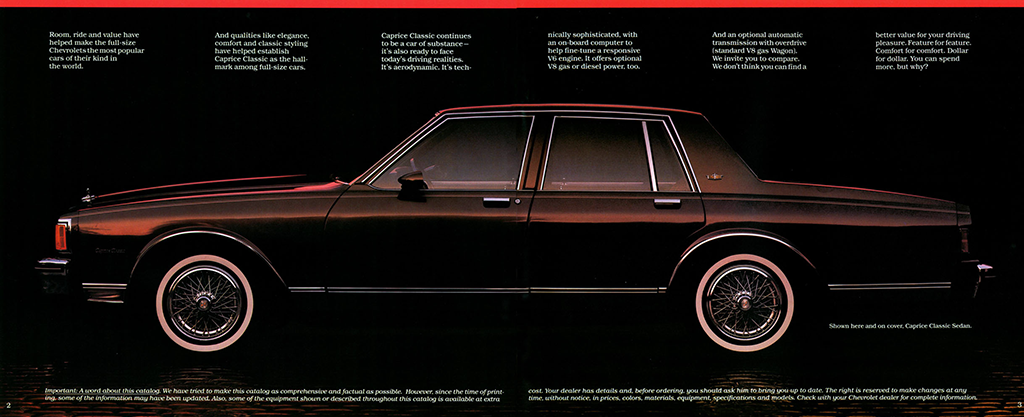A 1983 Chevrolet Monte Carlo SS with 156 miles recently sold on Bring a Trailer for $32,000.
“Chevy SS tradition comes alive …”
In the middle of the 1983 model year, Chevrolet announced the Monte Carlo SS. Designated RPO Z65, the SS was designed to help Chevrolet compete better in NASCAR on Sundays—and sell more Monte Carlos on Mondays. There were only two exterior color choices—White and Medium Dark Royal Blue. The changes in the front end and the addition of a rear spoiler cut the drag coefficient by 15% compared to the “civilian” Sport Coupe, making it a respectable 0.375, though not quite the Ford Thunderbird coupe‘s 0.35 Cd.
Aside from the exterior looks, the powertrain was the star—an L69 “H.O.” 175 bhp 5.0 liter/305 ci V8 with a four-barrel carburetor paired with a three-speed automatic transmission. Period road tests resulted in 0-60 mph times of about 8 seconds—about as quick as the Monte’s Buick Regal T-Type and Oldsmobile Cutlass Calais Hurst/Olds platform-mates in the same year. Fuel economy was rated at 17 city/25 highway by the day’s standards (14 city/18 highway by 2022 measures). With an 18.1-gallon gas tank, the enthused new owner of a Monte Carlo SS could expect a range of 260 to 340 miles with a 10% fuel reserve.
Standard exterior and mechanical equipment for the $10,249 Monte Carlo SS included Sport mirrors, a rear spoiler, a dual outlet exhaust system, power steering, the F41 sport suspension, power front disc/rear drum brakes, and Goodyear Eagle GT P215/65R15 white letter tires (a size still readily available) on 15 x 7 inch stamped steel wheels. Inside, the SS was less differentiated, but it did get a gage package with a tachometer. The standard seat was a blue cloth bench seat with white vinyl inserts and matching door trim.
Options & Production Numbers
Many of the standard Sport Coupe’s options were also available for the SS. Exterior examples included tinted glass ($105), hi-beam halogen headlamps ($10), and twin remote Sport mirrors ($60). Inside, options included an intermittent windshield wiper system ($49), an electric rear window defogger ($135), power windows ($180), an electric power door lock system ($120), a power trunk opener ($40), automatic speed control with resume speed ($170), a Comfortilt steering wheel ($105), and air conditioning ($725).
A blue cloth 55/45 seat with white vinyl inserts was available for an extra $133, but no bucket seats were available for the 1983 Monte Carlo. A series of four radios were available, with an AM/FM stereo radio with stereo cassette tape and four speakers ($298) being the top of the line. A fixed mast black antenna was an SS-only option and was included with all radios.
The sportier Monte Carlo was generally received in the press, though many scribes noted the lack of a console, bucket seats, Positraction, and a four-speed automatic—all issues Chevrolet promised to fix. Motor Trend‘s title was “Mid-American GT Revival,” and much of the coverage agreed.
Along with the late introduction, there were production problems in 1983, so the first year total for the fourth-generation Monte Carlo SS was only 4,714. SS sales would hit their stride in the following year, with Chevrolet moving 24,050 out the door.
The View From 2022
According to Hagerty’s valuation tools, all the money for a 1983 Chevrolet Monte Carlo SS Sport Coupe in #1/Concours condition is $27,700, with a far more normal #3/Good condition version going for $13,900.
These Monte Carlos have enthusiastic forum support, and there is definite collector interest. Monte Carlos SS coupes are often available in the Hemmings Motor News classifieds, on eBay Motors, and at online auctions such as Bring a Trailer that cater to the eighties car market.
Make mine Medium Dark Royal Blue, please.
I’ve written about one other Monte Carlo—the 1981 Sport Coupe. Other sporty G-platform cars I have written about include the 1980 Pontiac Grand Prix SJ coupe and the 1982 Buick Regal Grand National coupe.











